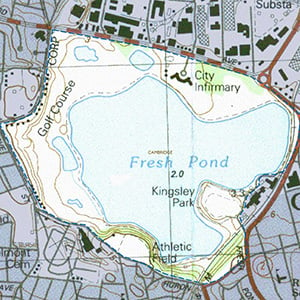Important Bird Area Sites in Massachusetts
Important Bird Area: Fresh Pond
Site Summary
Nominated By
Taber Allison
Size
240 acres
Towns and Counties
Cambridge; Middlesex
Ownership
Cambridge water department
Major Habitats
oak-conifer forest, lake/pond, urban/suburban
Land Use
recreation or tourism, water supply, suburban/residential, urban/industrial/ commercial
Serious Threats
hydrologic changes
Minor Threats
soil erosion, degradation
Site Description
Fresh Pond is a large body of water located in west Cambridge. As recently as the late 1800s, Fresh Pond was still located in a wetlands complex of the Alewife Brook drainage. Subsequent land filling and drainage, primarily for commercial development, has destroyed most of the wetlands, although several small ponds remain in the vicinity of Fresh Pond. The pond is a recreational and ornithological oasis in a densely populated semiurban landscape, and as described below it is an important migratory stopover for waterfowl. The pond perimeter is fenced and surrounded by a dirt-and-paved, heavily used, walking trail. A very narrow strip of trees line the pond along the inside of the fence, and a wider belt of woodland surrounds most of the pond. The vegetation of the woodland is a mixture of native and nonnative species and naturally established and planted individuals. The western boundary of the pond is level and includes a nine-hole public golf course; the eastern border of the pond slopes steeply upward to Fresh Pond Parkway.
Current Conservation Status
Fresh Pond is surrounded by residential and commercial development. Major roads run near the north and eastern boundaries of the pond, with only a narrow woodland buffer between the roads and the water, except near the water treatment plant where there is little or no buffer. The trail that runs around the pond receives heavy use and is a popular area for dog owners. Dogs are rarely controlled, run off the trai,l and routinely swim in the smaller ponds. The smaller ponds are regularly frequented by dabbling ducks, and occasionally by diving ducks such as Hooded Mergansers. New grass plantings are torn up by dogs running off the trail, despite the efforts of the city to encourage people to keep their dogs on the trails. A chain-link fence runs the perimeter of the pond and keeps bathers and dogs out of the water, which protects water quality and provides some security for waterfowl on the larger pond. The adjacent golf course is a potential source of herbicide and fertilizer, which may run off and make its way into the pond. A Master Plan for Fresh Pond was recently completed by a committee of local citizens and city of Cambridge Water Department staff; implementation of this plan is now being completed. The plan calls for conversion of the construction staging area into a meadow with bird and butterfly habitat, although the small size of the planned meadow will probably limit its suitability as nesting habitat for grassland or shrubland birds.
Ornithological Significance
Fresh Pond provides an important migratory stopover and winter habitat for waterfowl. The most abundant and frequently cited species, as summarized from count data supplied by M. Rines, and personal observations are typically Ruddy Duck, Canvasback, Ring-necked Duck, American Wigeon, American Coot, and Pied-billed Grebe. The maximum number observed for each species is recorded in the following table. Other species frequently observed over an eight-year observation period (1994-2002) include Canada Goose, Common Merganser, Hooded Merganser, Greater Scaup, Lesser Scaup, and Bufflehead. Mallards and Ring-billed Gulls, although not recorded in the database provided by M. Rines, were observed regularly and in abundance in 2001-2002. In addition the Black Scoter, Common Goldeneye, Eurasian Wigeon, Green-winged Teal, Redhead, Common Loon, Gadwall, and Wood Duck have been observed infrequently (1 to 2 times in nine years).
Other Flora or Fauna of Significance
None mentioned.
Data Sources
Personal observations compiled by M. Rines and T. Allison.
Recently published Fresh Pond Master Plan. Jim Barton on Advisory Board (J. Barton on Fresh Pond file).
Detailed vegetation description available.




